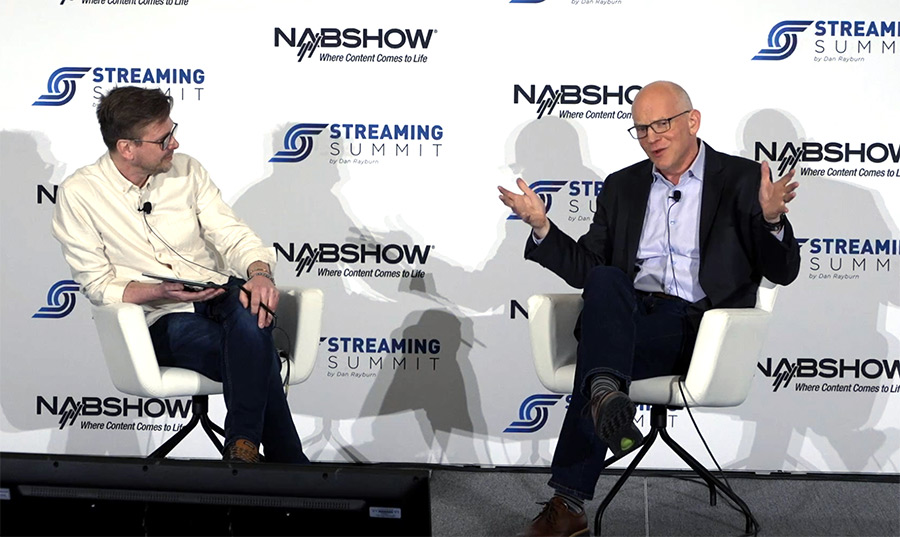Mediaroom is the world’s number one IPTV platform by market share. Recognized for its robust performance, quality, and stability, Mediaroom excels at large-scale global IPTV operations, offering the most reliable option for content delivery for operator managed networks. By applying multicast transmission to live video, Mediaroom optimizes bandwidth, delivering identical video streams to multiple users simultaneously without increasing network traffic load with user growth. This approach leads to substantial cost savings for TV service providers.
Mediaroom was originally designed for TV household consumption but has since adapted to the evolution of consumer needs. It now provides viewers the option to consume TV over any network, in any location, on any device at home or beyond.
MediaKind understands the need for service providers to remain competitive and have solutions that combine the scale of traditional IPTV with the flexibility of video streaming. Mediaroom is the solution designed for just that, spanning beyond the managed network.
In this blog, we’ll cover:
- The benefits of Adaptive Bitrate Streaming (ABR).
- How Mediaroom, while still supporting the legacy RTP video delivery designed for large-scale IPTV delivery over the operator’s managed network, continues to evolve, to leverage the benefits from ABR streaming protocols.
- Why MediaKind’s solution is the best solution for Mediaroom operators to ensure a smooth and cost-effective transition to next-generation TV while ensuring the best user experience and customer retention.
Mediaroom evolution to Adaptive Bitrate Streaming
Adaptive Bitrate streaming (ABR) protocols, such as Apple’s HTTP Live Streaming (HLS) and MPEG-DASH, enable seamless playback of video content across diverse network conditions. Some of the benefits of ABR are:
- Dynamic quality adjustments: The player monitors available bandwidth and latency and requests the video segments with the bitrate that best suits the network conditions and device capabilities.
- Based on Internet standards: ABR protocols are HTTP-based, which simplifies content delivery over the internet. Service Providers can work with any CDN vendor of their choice. Also, ABR has been widely adopted by all types of consumer devices, and can be used to deliver video to smartphones, tablets, smart TVs and more.
- Content protection: each video segment is encrypted and access to the content decryption keys is protected by DRM.
- Personalization: Manifest manipulation enables personalized experiences during playback of ABR content, including target advertising.
While still supporting the legacy RTP video delivery that was designed for large-scale IPTV delivery over the operator’s managed network, Mediaroom has evolved and continues to evolve to support ABR protocols and leverage the benefits of ABR streaming. Mediaroom supports ABR as follows:
- Video playback for non-live content can be played from an HTTP origin (typically over a CDN). This functionality initially used Microsoft’s Smooth Streaming protocol. However, it has now been enhanced, and the latest Mediaroom releases support playback using CMAF/DASH protocol, with content protection based on PlayReady DRM, and is available for all Mediaroom STBs (WinCE, Linux, and Android TV). This covers Video on Demand (VOD), recently aired programs and time-shifted live TV (when available based on applicable content rights), and Cloud DVR (DVR recordings recorded within a network recorder and played back using ABR protocols). Those features are documented as “external VOD”, “external restart TV” and “cloud DVR” respectively within Mediaroom documentation.
- Mediaroom supports Dynamic Ad Insertion (DAI) when using DASH playback. Mediaroom has been certified and pre-integrated with MediaKind’s Prisma product (Server-side ad insertion).
- Custom applications running within the Mediaroom STB can also play video from an external origin, based on Smooth Streaming or DASH protocol, either unencrypted or encrypted using PlayReady DRM.
- Video playback of live content using DASH is supported in the latest Mediaroom releases. This feature can be particularly useful for long-tail content, where the advantages of adaptive bitrate (ABR) video delivery—such as common AV delivery with unmanaged devices, stream personalization, and dynamic ad insertion—outweigh the cost efficiency of multicast video delivery.
- Additional features, such as support for enhanced ABR video delivery, with Instant Channel Change and low latency based on MediaKind’s Wave technology, will be released soon. Mediaroom is being evolved to completely remove any dependency from the managed network, so that service providers have the flexibility to provide TV services beyond or without the managed network.
In summary, Mediaroom, while still supporting the legacy RTP video delivery that was designed for large-scale IPTV delivery over the operator’s managed network, has evolved and currently supports delivery of all non-live video playback use cases using CMAF/DASH protocol, and continues to evolve with the recent addition of live playback using CMAF/DASH and its ongoing evolution to enhanced ABR video delivery.
Smooth and cost-effective transition to next-generation TV
MediaKind understands that in order for service providers to remain competitive, they need solutions that achieve both the large scale of traditional IPTV delivery and the flexibility of video streaming. Mediaroom achieves this goal, allowing consumers to access TV from any location on any device. Mediaroom’s evolution to Adaptive Bitrate Streaming is described as follows:
- Leverage your existing Set–Top Boxes (STBs) in the field: Mediaroom operators can evolve and consolidate their AV delivery platforms, while continuing to use their existing Mediaroom Set-Top Boxes, avoiding the need to replace the Set-Top Box devices. By not forcing subscribers to replace their existing STBs, service providers won’t risk subscriber loss due to changes in user interfaces.
- Mediaroom companion client (beyond STBs): In addition to accessing TV services from the Mediaroom STBs, consumers expect access from other devices (such as smartphones, streaming devices, Smart TVs, and more), from any network (high-speed internet, Wi-Fi or cellular), at any location (at home, or out of home). MediaKind enables this via its companion client solution for Mediaroom. At Service Providers where a companion client was introduced to complement the STB, a significant number of subscribers are regularly and actively using the companion client on smartphones and tablets (between 4% and 17% of the users depending on the consumer demographics). Access from other streaming devices (such as FireTV or other) connected to consumers’ TVs is also increasing in demand. The MediaKind companion solution for Mediaroom is an optional add-on to Mediaroom, to extend the TV service beyond the Mediaroom STBs, allowing consumers to enjoy the TV service anywhere. It is based on a fully managed and pre-integrated solution with minimal impact to existing operator processes and systems (for instance, it relies on existing Mediaroom BSS/OSS integrations, and does not require any new operator BSS/OSS work). The solution includes a client application for smartphones, tablets and Fire TV devices (more devices are optional), the ABR processing and delivery infrastructure for delivery of VOD and live content where allowed by content rights, and the TV Everywhere backend pre-integrated with Mediaroom servers to ensure a consistent user experience across devices. More details on the MediaKind companion solution for Mediaroom are described in a separate blog entry.
- Increased catalog size: increase the size of the VOD catalog that is available to your Mediaroom consumers, without being restricted by the capacity of your Mediaroom hardware infrastructure. ABR protocols allow for CDN caching, which will cache popular content, without having to reserve infrastructure capacity for long-tail content that is not frequently played.
- Monetization and personalization: ABR enables DAI. With VOD DAI, you can further monetize your service, with use cases such as Ad-Supported Video on Demand (AVOD), where consumers can stream movies and shows for free (or at a discounted rate), but with advertisements included. Since Mediaroom supports video playback of live content using DASH, service providers can now personalize live channels via manifest personalization, enabling use cases such as FAST channels.
- Infrastructure TCO Optimization: With Mediaroom support for CMAF/DASH, you don’t need to maintain multiple video delivery platforms for different types of devices. You can decommission Mediaroom V-Servers and TS-Servers and use a common ABR video encoding and delivery platform for Mediaroom STBs and other devices (such as smartphones, streaming devices, smart TVs and more). This can be a significant TCO optimization, as in some Service Providers V-Servers and TS-Servers represent as much as 30% of the dedicated Mediaroom infrastructure. You can share the video encoders, asset management systems, packagers and CDN to process and deliver TV content to all types of devices. Depending on customer needs, MediaKind can provide a pre-integrated end-to-end solution including the ABR video processing and delivery components, or can integrate with third-party components existing within the customer environment.
- Smooth AV pipe transition: Operators can choose to continue using legacy RTP video delivery, transition to ABR video delivery, or a combination of both. For instance, you can continue delivering a subset of your VOD catalog using the existing Mediaroom V-Servers, while starting to deliver another subset of your VOD catalog using DASH. This allows maximum utilization of your previous investments (e.g. Mediaroom hardware infrastructure), while you start deployment of your next-generation TV video delivery solution.
- Modularity and Deployment model flexibility: MediaKind’s solution is modular and supports multiple transcoding and origin products, including MediaKind’s MK.IO solution in the cloud, which allows for scalability to adapt to your workload needs as they evolve over time. Mediaroom servers can be deployed on-premise or in the cloud (with the only exception being components involved in multicast and RTP video delivery). Deploying in the cloud simplifies operations and lifecycle (no need to manage, maintain, or repair hardware). MediaKind can also provide Mediaroom and AV pipe components as a Managed Service or SaaS.
Summary and conclusion
MediaKind understands the need for service providers to remain competitive and the need for solutions that combine the large scale traditional IPTV delivery with the flexibility of video streaming.
MediaKind’s solution to address this challenge is based on evolving Mediaroom beyond the managed network, to support Adaptive Bitrate streaming (ABR), so the same video processing and delivery infrastructure can be leveraged for streaming devices and Mediaroom STBs. ABR ensures uninterrupted video playback, adapting to changing network conditions and device capabilities, using internet standards to deliver the content, enabling personalization, and ensuring content protection.
Mediaroom, while still supporting the legacy RTP video delivery, has evolved and currently supports delivery of all non-live video playback use cases using CMAF/DASH protocol. It continues to progress with the recent addition of live playback using CMAF/DASH as part of its ongoing evolution to enhanced ABR video delivery.
MediaKind’s solution ensures a smooth and cost-effective transition to next-generation TV services, by leveraging existing STBs, ensuring best user experience and customer retention, and by allowing the flexibility needed to allow for a smooth AV pipe transition and TCO optimization.
To know more and explore how MediaKind can help you in your transformation journey from Mediaroom traditional IPTV to your next-generation TV service, contact us.



